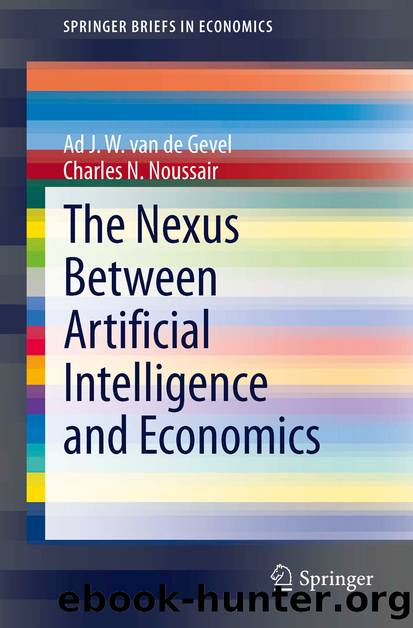The Nexus between Artificial Intelligence and Economics by Ad J. W. Gevel & Charles N. Noussair

Author:Ad J. W. Gevel & Charles N. Noussair
Language: eng
Format: epub
Publisher: Springer Berlin Heidelberg, Berlin, Heidelberg
5.6.2 Brain Computer Interface
Mind uploading can be seen as a migration process of the core mental functions, which are transferred from a human brain to an artificial environment. This process might be performed with a brain–computer interface, brain transplant or prosthesis.
A brain–computer interface (BCI) or a brain–machine interface (BMI), is a direct pathway of communication between the brain and an external device. BCIs are often aimed at assisting, augmenting, or repairing human cognitive or sensory-motor functions. Research on BCIs began in the 1970s at the University of California Los Angeles (UCLA) under a grant from the National Science Foundation, followed by a contract from DARPA. The field of BCI research and development has since focused primarily on neuroprosthetic applications that aim at restoring damaged hearing, sight and movement. Thanks to the remarkable plasticity of the cerebral cortex, signals from implanted prostheses can, after adaptation, be handled by the brain like natural sensor or effector channels. Following years of animal experimentation, the first neuroprosthetic devices implanted in humans appeared in the mid-nineties.
Neuroprosthetics is an area of neuroscience concerned with neural prostheses—using artificial devices to replace the function of impaired nervous systems or sensory organs. The most widely used neuroprosthetic device is the cochlear implant, which, as of 2006, has been implanted in approximately 100,000 people worldwide. There are several neuroprosthetic devices that aim to restore vision, including retinal implants.
The differences between BCIs and neuroprosthetics are mostly in the ways the terms are used: neuroprosthetics typically connect the nervous system to a device, whereas BCIs usually connect the brain (or nervous system) with a computer system. Practical neuroprosthetics can be linked to any part of the nervous system—for example, peripheral nerves—while the term “BCI” usually designates a narrower class of systems which interface with the central nervous system. Sometimes the terms are used interchangeably. Neuroprosthetics and BCIs seek to achieve the same aims, such as restoring sight, hearing, movement, ability to communicate, and even cognitive function. Both use similar experimental methods and surgical techniques.
A distinction can be made between invasive and non-invasive BCIs. Invasive BCI research aims at repairing damaged sight and providing new functionality to persons with paralysis. Invasive BCIs are implanted directly into the grey matter of the brain during neurosurgery. Since they rest in the grey matter, invasive devices produce the highest quality signals among BCI devices. However, they are prone to create scar-tissue build-up, causing the signal to become weaker or even lost, as the body reacts to a foreign object in the brain.
Besides invasive experiments, there have also been experiments in humans using non-invasive, neuroimaging technologies as interfaces. Signals recorded in this way have been used to power muscle implants and restore partial movement in an experimental volunteer. Although they are easy to wear, non-invasive implants produce poor signal resolution because the skull dampens signals, dispersing and blurring the electromagnetic waves created by the neurons. Although the waves can still be detected, it is more difficult to determine the area of the brain that is exhibiting activation.
Electroencephalography
Download
This site does not store any files on its server. We only index and link to content provided by other sites. Please contact the content providers to delete copyright contents if any and email us, we'll remove relevant links or contents immediately.
International Integration of the Brazilian Economy by Elias C. Grivoyannis(85298)
The Radium Girls by Kate Moore(11858)
Turbulence by E. J. Noyes(7888)
Nudge - Improving Decisions about Health, Wealth, and Happiness by Thaler Sunstein(7451)
The Black Swan by Nassim Nicholas Taleb(6937)
Rich Dad Poor Dad by Robert T. Kiyosaki(6307)
Pioneering Portfolio Management by David F. Swensen(6164)
Man-made Catastrophes and Risk Information Concealment by Dmitry Chernov & Didier Sornette(5870)
Zero to One by Peter Thiel(5629)
Secrecy World by Jake Bernstein(4588)
Millionaire: The Philanderer, Gambler, and Duelist Who Invented Modern Finance by Janet Gleeson(4283)
Skin in the Game by Nassim Nicholas Taleb(4118)
The Age of Surveillance Capitalism by Shoshana Zuboff(4111)
The Money Culture by Michael Lewis(4016)
Bullshit Jobs by David Graeber(3982)
Skin in the Game: Hidden Asymmetries in Daily Life by Nassim Nicholas Taleb(3863)
The Dhandho Investor by Mohnish Pabrai(3629)
The Wisdom of Finance by Mihir Desai(3599)
Blockchain Basics by Daniel Drescher(3422)
